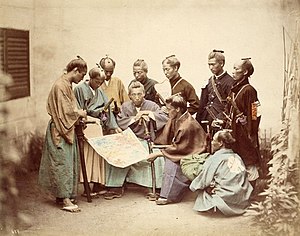
Satsuma Motohira Katana
S0176
SOLD
An ubu signed and dated Satsuma Motohira katana in Satsuma koshirae. Signed tachi mei, Satsuhan Oku Yamato Daijo Ason Motohira / Kansei Ni Nen Tora-tsuchino Ni Gatsu Jitsu (a day in February, fifteenth year of the cycle, 1790), so this was made when he was 53 years old. Hawatare: 2 Shaku 5 sun 5 bu (77.27 cm or 30.42"). Motohaba: 3.4 cm. Sakihaba: 2.5 cm. Kasane: 7 mm. There are thirty-seven juyo token prior to Heisei juichi nen (1999), all katana with nagasa from 67 cm to 78.1 cm. Kitae: itame hada, ji nie, profuse extended chikei, gifu. Hamon: gunome, gunome togare, choji, wide and deep ashi iri within notare midare nie deki with a very wide and deep habuchi. Profuse ha nie, nijuba, tobiyaki, kinsuji, hataraki, short patterns, which if they were longer, would be imozuru, nado. Ubu nakago, sujikai yasuri mei, two mekugi ana. In the case of double mekugi ana the second ana is typically placed at the end of the nakago, but this is as far down as it can be cut due to the shape of the nakago. He is rated Jojo saku in Nihon Toko Jiten - Shinto Hen by Fujishiro, valued at 7,000,000 yen in Shibata's Toko Taikan, listed with a double square in Nihonto Meikan. Hozon kanteisho on both the blade and koshire. There are two available juyo Motohira being offered on Japan sites, one at $135,317 with koshirae and the other at $120,556 in shirasaya.
Koshirae: Black lacquer Satsuma saya with classic Satsuma kurikata and kaeri zuno. A large ko kinko tsuba 7.79 cm. x 7.5 cm. of rich black shakudo with a nanako ground, blue black polished shakudo leaves and stems, with chrysanthemums in silver and gold utori. As per Robert Haynes, 'a first rate Daimyo grade tsuba, circa. 1500 to 1550, perhaps just short of juyo'. The fuchi-kashira are Yoshioka shakudo with a deeply caved wave pattern with gold three five three kiri. The external menuki are silver chrysanthemums. Heavy gold foil seppa. That the Satsuma were loyal to the emperor is illustrated in the kiri and chrysanthemum motif in the koshirae and the sword bag. They played a pivotal role in the Meiji restoration. The Boshin Senso (1868-1869) pitted the Imperial forces, primarily of Satsuma and Choshu, against those of the Tokugawa shogunate.
Born 1737, he died July 15, 1826 at the age of 83. His early work is signed Satsuyo Shi or Satsu Han Kerai, he received the title of Yamato no Kami in Kansei gannen (1789). The signatures that he cut in his youth were larger and more exact than his later work. The works of his youth are most plentiful.
Satsuma Samurai During The Period of The Boshin Senso
Photograph by Felice Beato (3740)
Kansei Ni Nen Tora-tsuchino Ni Gatsu Jitsu
Satsuma Oku Yamato Daijo Ason Motohira